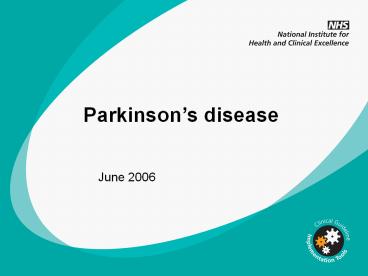Parkinson’s disease - PowerPoint PPT Presentation
1 / 24
Title:
Parkinson’s disease
Description:
Parkinson s disease June 2006 changing clinical practice NICE guidelines are based on the best available evidence the Department of Health asks NHS organisations to ... – PowerPoint PPT presentation
Number of Views:869
Avg rating:3.0/5.0
Title: Parkinson’s disease
1
Parkinsons disease
June 2006
2
changing clinical practice
- NICE guidelines are based on the best available
evidence - the Department of Health asks NHS organisations
to work towards implementing guidelines - compliance will be monitored by the Healthcare
Commission
3
Parkinsons disease
Parkinsons disease (PD) is a progressive
neurodegenerative condition diagnosis is
primarily clinical, based on history and
examination
4
symptoms
- classically include
- slow movements (bradykinesia)
- rigid or stiff muscles
- tremor
- other symptoms can include
- psychiatric problems
- autonomic disturbances and pain
- progression to significant disability and handicap
5
need for this guideline
- PD is a common, chronic, progressive neurological
condition - significant impact on patients and carers
- prompt, accurate clinical diagnosis is important
6
incidence and prevalence
- PD is estimated to affect 100180 in 100,000
people - annual incidence of 420 per 100,000
- rising prevalence with age
- higher prevalence and incidence of PD in males
- depression affects around 40 of PD patients
7
key priorities -referral, diagnosis and review
- people with suspected PD should be referred
quickly and untreated to a specialist - diagnosis of PD should be reviewed regularly and
reconsidered if atypical clinical features
develop - acute levodopa and apomorphine challenge tests
should not be used in differential diagnosis
8
suggested actions
- review and update services
- care pathways and collaboration between sectors
- local commissioning arrangements and service
- capacity
- current practices around referrals and need to
refer - untreated
- review provision of service capacity around
follow- - up appointments
- review current protocols around diagnostics,
- medication protocols, shared care protocols and
formularies - to ensure they are in line with guideline
9
diagnostic techniques
- SPECT should be considered for people with tremor
and should be available to specialists with
expertise - PET should not be used in differential diagnosis
of PD syndromes except in context of clinical
trials - MRI should not be used in differential diagnosis
of PD but may be considered for differential
diagnosis of PD syndromes
10
diagnostic techniques
- Magnetic resonance volumetry should not be used
in the differential diagnosis of PD syndromes
except in context of clinical trials - Magnetic resonance spectroscopy should not be
used in the differential diagnosis of
parkinsonian syndromes - Objective smell testing should not be used in the
differential diagnosis of parkinsonian syndromes
except in context of clinical trials
11
key priorities - provide access to services
- PD patients should have regular access to
- monitoring and alteration of medication
- a continuing point of contact
- a reliable source of information
- which may all be provided by a PD Nurse
Specialist - physiotherapy, speech and language therapy, and
occupational therapy should be available
12
suggested actions
- make sure there are enough trained staff to
provide specialist nursing care and to prescribe
and monitor patients medications - make sure there are enough
- physiotherapists
- occupational therapists
- speech and language therapists
- review skill mix of physiotherapists, speech and
language therapists, and occupational therapists
13
key priorities - palliative care
- palliative care should be considered during all
phases - people with PD and carers should be given
opportunity to discuss end-of-life issues with
appropriate healthcare professionals
14
suggested actions
- review service capacity and provide training to
ensure that palliative care needs are considered - review patient information and make sure it is
useful
15
(No Transcript)
16
pharmacological therapy
- no universal first choice drug therapy
- choice of adjuvant drug should take into account
- clinical and lifestyle characteristics
- patient preference
17
early disease
18
pharmacological therapy
- most people with PD will develop motor
complications - eventually will require Levodopa therapy
- prescribed adjuvant drugs alongside Levodopa to
reduce motor complications and improve quality of
life
19
late disease
20
drug administration considerations
- antiparkinsonian medication should not be
withdrawn abruptly or allowed to fail suddenly - practice of withdrawing patients to reduce motor
complications should not be undertaken - medication should be given at appropriate times
and adjusted after discussion with a specialist - clinicians should be aware of dopamine
dysregulation syndrome and management
difficulties
21
non-motor features of PD
- can include
- mental health problems
- depression
- psychotic symptoms
- dementia
- sleep disturbance
- falls
- autonomic disturbance
22
costs and savings
- recommendations considered to have greatest
impact on resources - savings
- reduced admissions and outpatient attendances
- costs
- referrals to rehabilitative therapy services and
regular specialist nursing care
23
access tools online
- costing tools
- costing report
- costing template
- implementation advice
- available from www.nice.org.uk/CG035
24
access the guideline online
- quick reference guide a summary
www.nice.org.uk/CG035quickrefguide - NICE guideline all of the recommendations
www.nice.org.uk/CG035niceguideline - full guideline all of the evidence and
rationale www.nice.org.uk/CG035fullguideline - information for patients and carers a plain
English version www.nice.org.uk/CG035publicinfo































